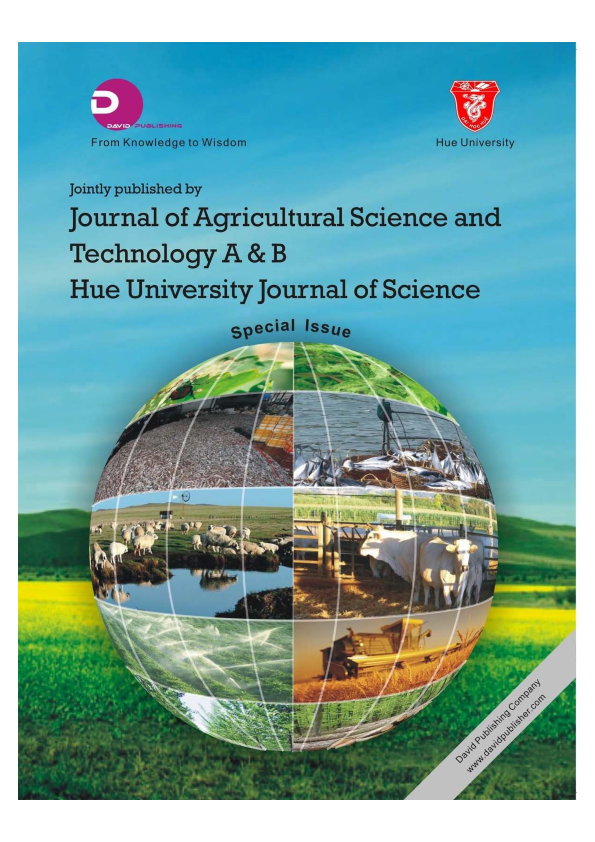PRELIMINARY STUDIES ON THE TOXIC EFFECTS OF DEGRADATION PRODUCTS OF OXYTETRACYCLINE AND CHLORTETRACYCLINE ON RATS
Abstract
The toxic effects of the degradation products of oxytetracycline and chlortetracycline, α-apo-oxytetracycline (α-apo-OTC), β-apo-oxytetracycline (β-apo-OTC), anhydro-chlortetracycline (ACTC) and 4epi-anhydro-chlortetracycline (EACTC) were studied in rats. Male rats received oral doses of 10 mg/kg body weight/day of either α-apo-OTC, β-apo-OTC, ACTC or EACTC 90 days. At the end of 90 days treatment, we measured body/organ weight, white blood cell count (WBC), red blood cell count (RBC), hemoglobin (HGB), hematocrit (HCT), platelet (PLT) count, blood urea nitrogen (BUN), serum glutamic oxaloacetic transaminase (SGOT) and serum glutamic pyruvic transaminase (SGPT). The results revealed that the rats treated with α-apo-OTC or ACTC for 90 days did not affect body/organ weights or certain blood- and serum-factors, however, those treated with β-apo-OTC or EACTC exhibited significant decreases in body weights, RBC counts and HGB concentrations, as well as significant increases in BUN concentrations, SGOT and SGPT activities. The results of this study suggest that the toxic effects of β-apo-OTC or EACTC treatment could damage liver and kidney tissues of rats, as well as lead to the degeneration and necrosis in the hepatocytes.
Key words: Antibiotic, oxytetracyline and chlortetracycline degradation products, toxic effect, rats
References
Farombi, E.O., Ugwuezunmba, M.C., Ezenwadu, T.T, Oyeyemi, M.O., Ekor, M., Tetracycline-induced reproductive toxicity in male rats: Effects of vitamin C and N -acetylcysteine. Experimental and Toxicologic Pathology., 2008. 60: p. 77-85.
Asha, K.K., Sankar, T.V. and Nair, P.G., Effect of tetracycline on pancreas and liver function of adult male albino rats. J. Pharm Pharmacol., 2007. 59: p. 1241-1248.
Kuhne, M., Hamscher, G., Korner, U., Schedl, D., Wenzel, S., Formation of anhydrotetracycline during a high-temperature treatment of animal-derived feed contaminated with tetracycline. Food Chem, 2001. 75: p. 423-429.
Gratacós-Cubarsí, M., Fernandez-Garcia, A., Picouet, P., Valero-Pamplona, A., Garcia-Regueiro, J-A., Castellari, M., Formation of Tetracycline Degradation Products in Chicken and Pig Meat under Different Thermal Processing Conditions. J. Agric. Food Chem, 2007. 55: p. 4610−4616.
Fedeniuk, R.W., Shand, P.J. and McCurdy A.R., Effect of thermal processing and additives on the kinetics of oxytetracycline degradation in pork muscle. J. Agric. Food Chem., 1997. 45: p. 2252-2257.
Frimpter, G.W., Timpanelli A.E., Eisenmenger W.J., Stein, H.S., Ehrlich, L.I., Reversible "Fanconi Syndrome" caused by degraded tetracycline. JAMA., 1963. 184(2): p. 111-113.
Benitz, K.F. and Diermeier, H.F., Renal toxicity of tetracycline degradation products. Proc Soc Exp Biol Med., 1964(115): p. 930-935.
Halling-Sorensen, B., Sengelov, G. and Tjornelund, J., Toxicity of Tetracyclines and Tetracycline Degradation Products to Environmentally Relevant Bacteria, Including Selected Tetracycline-Resistant Bacteria. Arch. Environ. Contam. Toxicol., 2002. 42: p. 263-271.
Guo, R.X. and Chen, J.Q., Phytoplankton toxicity of the antibiotic chlortetracycline and its UV light degradation products. Chemosphere., 2012. 87: p. 1254-1259.

